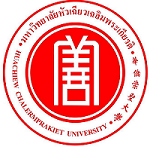Please use this identifier to cite or link to this item:
https://has.hcu.ac.th/jspui/handle/123456789/4280| Title: | Association of Neuroprotective Effect of Di-O-Demethylcurcumin on Aβ25-35-Induced Neurotoxicity with Suppression of NF-κB and Activation of Nrf2 |
| Authors: | Decha Pinkaew Chatchawan Changtam Chainarong Tocharus Piyarat Govitrapong Pichaya Jumnongprakhon Apichart Suksamrarn Jiraporn Tocharus เดชา ปิ่นแก้ว ชัชวาลย์ ช่างทำ ชัยณรงค์ โตจรัส ปิยะรัตน์ โกวิทตรพงศ์ พิชย จำนงค์ประโคน อภิชาต สุขสำราญ จิราภรณ์ โตจรัส Chiang Mai University. Faculty of Medicine Huachiew Chalermprakiet University. Faculty of Science and Technology Chiang Mai University. Faculty of Medicine Mahidol University. Research Center for Neuroscience Chiang Mai University. Faculty of Medicine Ramkhamhaeng University. Faculty of Science Chiang Mai University. Faculty of Medicine |
| Keywords: | Alzheimer’s disease โรคอัลไซเมอร์ Di-O-demethylcurcumin Amyloid-β peptides อะไมลอยด์เบตาเปปไทด์ Nuclear factor erythroid 2-related factor 2 Nuclear factor-κB Oxidative stress ภาวะเครียดออกซิเดชัน |
| Issue Date: | 2016 |
| Citation: | Neurotox Res 2016 Jan;29(1):80-91. |
| Abstract: | Amyloid-β peptides (Aβ), a major component of senile plaques, play an important role in the development and progression of Alzheimer's disease. Several lines of evidence have demonstrated that Aβ-induced neuronal death is mediated by oxidative stress. The present study aimed to evaluate the potential involvement of di-O-demethylcurcumin, an analog of curcuminoid, on Aβ-induced neurotoxicity in culture neuroblastoma cells (SK-N-SH cells) through the activation of nuclear factor erythroid 2-related factor 2 (Nrf2) signaling pathway and the suppression of nuclear factor-κB (NF-κB) signaling pathway and their downstream targets. The results showed that pretreatment with di-O-demethylcurcumin elevated cell viability and decreased the level of reactive oxygen species. Moreover, treatment with di-O-demethylcurcumin promoted the translocation of Nrf2 protein from the cytoplasm to the nucleus, increased the expression of Nrf2-ARE pathway-related downstream proteins including heme oxygenase (HO-1), NAD(P)H:quinone oxidoreductase 1 and glutamate-cysteine ligase catalytic subunit, and increased the activity of superoxide dismutase enzymes. On the other hand, di-O-demethylcurcumin suppressed the degradation of IκBα, translocation of the p65 subunit of NF-κB from cytoplasm to nucleus and thereby, attenuated the expression of inducible nitric oxide synthase protein and nitric oxide production. Taken together, these results suggest that neuroinflammatory effect of di-O-demethylcurcumin might potentially be due to inhibit NF-κB and activate Nrf2 signaling pathways induced by Aβ25-35. |
| Description: | สามารถเข้าถึงบทความฉบับเต็ม (Full Text) ได้ที่ : https://pubmed.ncbi.nlm.nih.gov/26358194/ |
| URI: | https://has.hcu.ac.th/jspui/handle/123456789/4280 |
| Appears in Collections: | Science and Technology - Articles Journals |
Files in This Item:
| File | Description | Size | Format | |
|---|---|---|---|---|
| Association-of-Neuroprotective-Effect-of-Di-O-Demethylcurcumin.pdf | 81 kB | Adobe PDF | View/Open |
Items in DSpace are protected by copyright, with all rights reserved, unless otherwise indicated.
